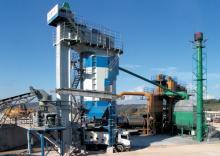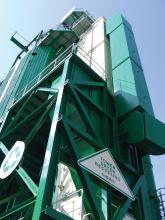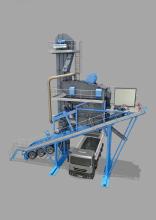
Innovative plants capable of producing a huge variety of mixes are coming to the market. Patrick Smith reports
Concrete, a highly energy and CO2-efficient building material is, after water, globally the second most consumed commodity by volume.
It is used in all infrastructure projects and it has been estimated that each year over 1m³ is produced for every person on earth.
Concrete plant manufacturers have been introducing new equipment but the use of such equipment depends on the amount of construction being carried out.
“In terms of the [UK] market we all know that this year the concrete market as a whole will be down probably by 2-3% and I think the way we have seen the market is that it will be as bad as in the second half of 2008,” says Paul Lacey,
“London flies in the face of this completely because of infrastructure projects including Crossrail and the Olympics. One of the reasons we have invested in the Acton plant (see panel) is because of Crossrail. It is a significant proportion as is high rise.”
However, many other countries in Europe are experiencing demand for equipment as roads, bridges and other infrastructure projects gather pace.
“The market expansion for concrete mixing plants is driven on an international scale from the robust Swiss market place,” says the Swiss-based
The EcoMix and GlobalConcrete model ranges round off its product portfolio, with the EcoMix tower plant meeting with “keen interest.” Two plants are already working in Switzerland.
Producing “all known concrete mixes,” the EcoMix offers production outputs of 60-190m3/hour using the Amix twin-shaft paddle mixer while the Global model range has been developed with the advance of globalisation in mind.
“The ability to serve domestic markets with competitive products defines the global standard of today. Emphasis was placed firmly on developing a plant with an interesting price-performance ratio. This horizontal plant is ideal for locations with slightly more generous space conditions,” says Ammann.
An interesting concept in concrete plants has been put forward by US company
To provide production of mixed materials, Astec took a closer look at the structural components of aggregates with a binder, such as asphalt cement for making hot mix asphalt (HMA) or Portland cement for making concrete. Both materials have a similar constituent make-up and the variable is the addition of either asphalt cement or Portland cement (with water or other additives) to create the desired mix.
“Most concrete for road building is produced in a plant with a mixer, either a tilt-drum mixer or a twin-shaft mixer. Every asphalt and concrete plant has components that help proportion the materials, including the sand,” says Astec. “The bin system in the ConAsphalt plant concept would be referred to as the Aggregate Management System, whereas on the asphalt plant, the units are called the cold feed bins, or referred to as aggregate bins on the concrete plant. The ConAsphalt plant would manage the production of both asphalt and concrete with the same group of aggregate bins.”
When the aggregates are moving up the incline conveyor to go into the [Astec] Double Barrel dryer/drum, there would be a calibration chute that would be modified to be a diverter chute, which would take the aggregates over to the twin-shaft mixer to make concrete or on to the dryer/drum for HMA.
Italian manufacturer
“Thanks to these inventions, the concrete batching plants MMX4000 can ensure an hourly output capacity of 100m3 of high quality concrete,” says Simem.
Lintec’s 100% ISO sea containers are used by the German company to transport its concrete plants, which have outputs ranging from 60m³-240m³/hour, and which include one of its latest additions, the CC 3000 B, a further development of its field-proven 3000 Series. This has been developed as a result of increased cost awareness of global customers and to meet the demand for stationary plants, but also to allow customers to use it as a mobile plant for various sites.
“Although the plant has been developed with fewer containers than its predecessor, it has the same output of about 120m³/hour of high quality concrete. Due to its modular construction the plant can be erected, transported and dismantled easily and within short time,” says Lintec.
Frumecar, the Spanish manufacturer, says its mission is to become a point of reference in the supply of machinery and technology for the concrete industry, including the marketing of spare parts and technical service as an added value.
“All our models are conceived and designed to solve the different problems that may arise regarding the siting needs of a mobile plant on-site. These models include a design conceived to locate the plant in very small spaces; the utmost simplicity of transport, and versatility to adapt the plant for expansion in storage, silos or wet,” says the company.
Another Spanish company, Serviplem-Telcon (Baryval) is exploring opportunities and has decided to extend its product range.
“We aim to offer to our clients a complete service within the sector of concrete and cement; batching plants have been incorporated into our product range,” says the company.
At WEC-Turmbau in Magdeburg, Germany, a
For the series production of the segments the concrete is made to precise mixture specifications and in Magdeburg a Betomat III-570 type Liebherr mixing plant is used. It stores 570m³ of aggregates in seven compartments in the silo above the system. This is conveyed via a bucket elevator and rotary distributor at a delivery rate of 140m³/hour. The storage volume of the four possible types of cement is 360m³.










